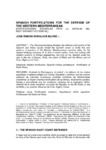Mostrar o rexistro simple do ítem
Spanish fortifications for the defense of the Western Mediterranean
| dc.contributor.author | Soraluce Blond, José Ramón | |
| dc.date.accessioned | 2016-11-03T11:41:27Z | |
| dc.date.available | 2016-11-03T11:41:27Z | |
| dc.date.issued | 2016 | |
| dc.identifier.uri | http://hdl.handle.net/2183/17511 | |
| dc.description.abstract | The Reconquista being finished, the defense and control of the Spanish and Italian coasts forced the Spanish crown to fortify the new systems of bastions of the Western Mediterranean maritime cities. As the largest fortifying company of its time it raised castles, forts and walling with modern systems of military engineering, not only on the Spanish coast but also in the city of Naples, Sicily, the island of Malta and the African port of Oran, Algiers and Tunis | es_ES |
| dc.description.abstract | Acabada la Reconquista, el control y la defensa de las costas españolas e italianas obligó a la Corona Española a fortificar con los nuevos sistemas de baluartes numerosas ciudades marítimas del Mediterráneo Occidental, la mayor empresa fortificadora de su tiempo, levantando castillos, fuertes y amurallando con los modernos sistemas de la ingeniería militar, además de la costa española, la ciudad de Nápoles, la isla de Sicilia, la isla de Malta y los puertos africanos de Orán, Argel y Túnez. | es_ES |
| dc.language.iso | eng | es_ES |
| dc.subject | Fortifications | es_ES |
| dc.subject | Western Mediterranean | es_ES |
| dc.subject | Fortificaciones | es_ES |
| dc.subject | Mediterráneo Occidental | es_ES |
| dc.subject | Fortificacións | es_ES |
| dc.subject | Spanish military architecture | es_ES |
| dc.subject | Fortifications of North Africa. | es_ES |
| dc.subject | Arquitectura militar | es_ES |
| dc.subject | Norte de Africa | es_ES |
| dc.title | Spanish fortifications for the defense of the Western Mediterranean | es_ES |
| dc.title.alternative | Fortificaciones españolas para la defensa del Mediterráneo Occidental | es_ES |
| dc.type | info:eu-repo/semantics/article | es_ES |
| dc.rights.access | info:eu-repo/semantics/openAccess | es_ES |
Ficheiros no ítem
Este ítem aparece na(s) seguinte(s) colección(s)
-
GI-GICAP - Artigos [36]






